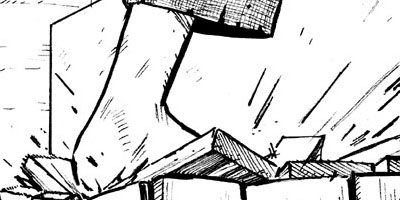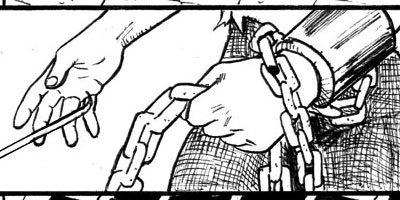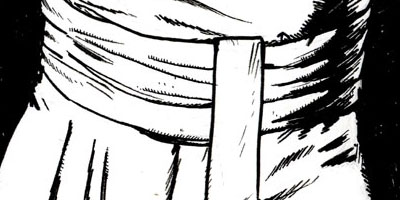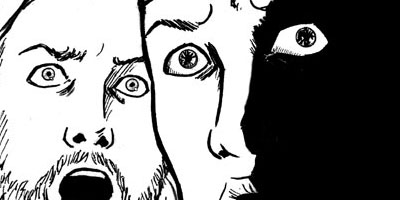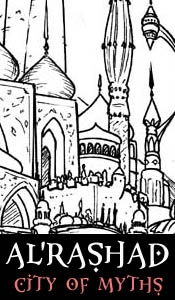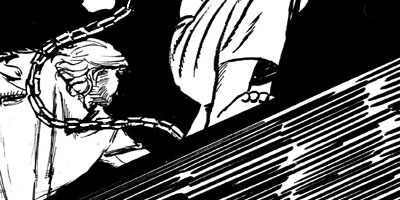
9
May
8
May
So Thor is… pretty good, all things considered. And this comes from someone who is avowedly not a fan of Thor comics, so for once I was approaching this more as a general moviegoer than somebody with the Fuck Yeah _____ t-shirt on. It has decent performances, fun enough action, some pretty decent dialogue and plot, gorgeous visuals and solid editing. It was a perfectly decent superhero movie.
That having been said – some critics have accused it of being bloodless or soulless, and although I don’t agree with them I can see where they’re coming from, because Thor really toes a line that’s been bothering me more and more vis-a-vis superhero movies. Thor in many ways feels like a different sort of exercise than what moviegoing should be like: what bothers me, however, isn’t the “this is the obvious Piece X in the set of pieces to make the Avengers movie happen” aspect of the film (which is certainly prevalent).
What bothers me about Thor is that, although it doesn’t quite cross the line, it definitely comes right up to it in that Thor feels like the balance between “let’s make a really good and faithful adaptation of some comics that were good” and “let’s make a good movie.”
When I talk about this I’m not talking about something like Watchmen, which is a slavish imitation of the original comics and way way over the line. That’s certainly an example of the problem, but a hyperbolic one. What I’m talking about instead is that Marvel’s movies – and looking at Green Lantern it appears DC is following the trend – have started to get a really slick, corporate feel to them. I know that sounds like an odd complaint (“wait, you’re saying that enormous movie studios are making corporate product? Shut your mouth”) so let me explain.
Basically, the filmmaking process for superhero movies is starting to feel less organic. Fans have praised Thor for being visually and thematically faithful to the Kirby vision of what Thor comics could be, and to that my response is “why is that faithfulness de facto praiseworthy?” Granted, after years of things like Nicolas Cage as Ghost Rider movie or Ang Lee’s Hulk1, I can see why comic fans might want to encourage filmmakers to stick closer to the existing ideas behind comics. But Fantastic Four, on the other hand, demonstrates that staying reasonably close to the existing formulae doesn’t necessarily mean a good movie either.
And the current crop of super-faithful movies don’t advance the characters or their overarching story: you only get that when you let filmmakers tinker a bit with the ideas. Superman wasn’t a Kansas farmboy until Superman: The Movie established that Smallville was in Kansas. Gotham City wasn’t the dark, nightmarish Gothic city that’s dominated the comics for two decades until Tim Burton and Anton Furst got their hands on Batman.2 If you want a smaller-scale example of how this can work, think about how the Blade franchise turned a Z-lister into a really cool bunch of B-movies, which is no small accomplishment when your main star is Wesley Snipes.3 Or how The Crow turned what was, let’s be honest, a pretty lousy comic into a pretty great movie.4
Thor is fun, but there’s no really new ideas to it: the closest you get is the exercise of making certain elements of a superhero mythos that might not work in a two-hour movie palatable for a mass audience, referenced as callbacks for nerds. Most of the modern crop of Marvel movies fit into this mold (the first Iron Man is an outlier, mostly because of Robert Downey Jr.’s performance). When critics complain about superhero movies becoming soulless, that’s what they mean. These movies don’t advance the story: they’re about “let’s make a Thor movie that’s just like what the comics would be if they were a movie!” And that’s kind of a shame.
- Yes, I know people have tried to reclaim it as a secret success. Those people are wrong. [↩]
- And then Christopher Nolan completely ignored what had become the standard and plainly portrayed Gotham as Chicago in his Batman movies, which again goes to show how a fresh take on a character can creatively rejuvenate a franchise. [↩]
- He used to be a big star at one point! [↩]
- Which then had pretty lousy sequels. [↩]
5
May
Everything about the Green Lantern movie looks awful. And this is completely dysjunct from the talent involved. I mean, I like Ryan Reynolds. I like Mark Strong. I like Peter Sarsgaard. I even enjoy Blake Lively as an actor (she was great in The Town). Even the smaller cast details are perfect: Geoffrey Rush voicing Tomar-Re, for example, or Angela motherfucking Bassett as Amanda Waller. I’ve always liked Martin Campbell as a director – I mean, come on, The Mask of Zorro! And although I dislike Hal Jordan as a character intensely, the movie seems to be playing him more like, well, Kyle Rayner, which was always the way to go.
But it still looks absolutely awful, right down to Hal’s domino mask (which straight-up needed to get tossed). They’re spending millions of dollars at the last minute, apparently, to make the CGI not un-terrible. Every action scene in the trailer looks like a mediocre video-game cutscene: the characters don’t feel real in any way, mostly because they aren’t. They’ve taken a loyalist approach to the comics, which in the trailers looks like a terrible, terrible idea – this is a property that needed some serious visual imagination and inventiveness to work as a movie, and instead it looks like they’ve just puked up the comics onscreen and said “okay, good enough.” They even use the Green Lantern oath in the trailer, and if ever there was something that just doesn’t work outside of a comic book, it’s the Green Lantern oath.
I can’t be the only one who thinks “oh my god this is crap,” can I?
(Between this and Thor – on which I am decidely lukewarm – it’s looking like Captain America is going to be the only promising superhero movie this year. Which is funny, because of the three, I think that would have been the one most fans would have said would be the least slam-dunkish.)
5
May
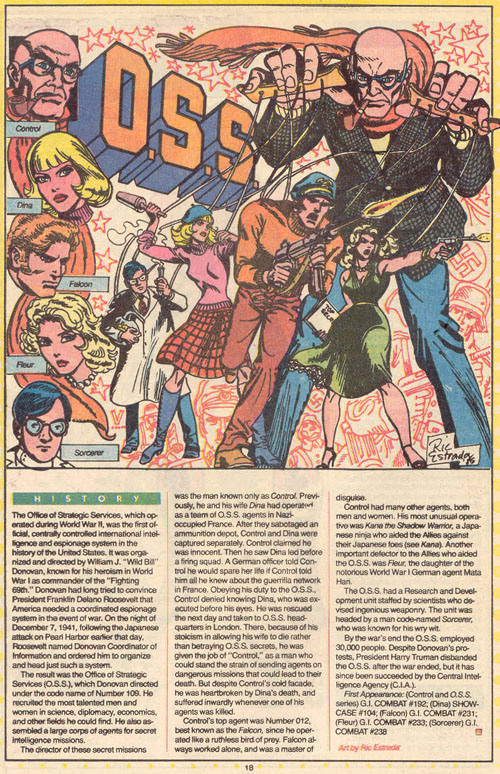
I don’t want anybody to get me wrong when I praise the DC Comics version of the O.S.S., which appeared in old war comics – mostly G.I. Combat – and were, well, basically war comics. War comics geared more towards espionage, obviously, with all the cool fripperies that World War II-era spying had on the side. But, yes, by and large, bog-standard war comics, really only noteworthy by the fact that Control – the dude with the pipe – was actually really awesome both visually and as a character, a predecessor in a lot of ways to the modern incarnation of Nick Fury (who’s become a lot different than the 60s-era Nick Fury, who was a glamourous secret agent rather than a byzantine spymaster). But other than that, nothing beyond perfectly good war comics.
But I love the idea that there’s more to work with here. Basically, what you have the potential for here is the World War II equivalent of Greg Rucka’s Checkmate: an espionage and spy comic set in a superhero universe. Except that here you’ve got the Golden Age equivalent: a spymaster working with a variety of secret agents to defeat Nazis (and the Dragon King, why not?) in the secret war-beneath-the-war. The tone would be pulpier than Checkmate is, because spying just plain used to be pulpier in the old days: Sten guns hidden in bushes, spy cameras baked into loaves of bread. But it’s the DCU, so you’d get the little touches that would make it worthwhile: an ongoing series of missions to attempt to seize the Spear of Destiny and/or Holy Grail, for example, to break the Axis’ magical wall preventing American superheroes from attacking them. Or maybe an undercover op to destroy the War Wheel Mark II before it can be deployed at Arnhem. Control could have any number of great and relatively underused Golden Age characters to call upon: the Crimson Avenger, the Jester, the Invisible Hood, Giovanni Zatara, G.I. Robot…
…the more I think about this, the more I want to write it.

4
May
In Neo-Washington the Rocket Robin Hood school of fashion holds sway
Posted by MGK Published in Comics, WTFI know predicting future fashions is never easy (really, I should at some point devote a post to the endless lineup of incredibly terrible civilian clothing in Legion of Super-Heroes over the years. – suffice it to say that the future? Is caftans), but if you end up with a future-military where plumed and/or finned helms are back in fashion, something has gone sharply wrong with your design sense.

For the record, this story ends when the emperor is driven insane by a plague-harmonica of his own creation.
I can’t believe I just wrote that sentence. But there you go. Weird War Tales is like that; the only way this could be more weirdly-warrish is if somehow it was revealed at the end that vampires were somehow to blame. Or, alternately, Space Hitler.
2
May
Incredibly timely and still totally relevant thoughts on Action Comics #900!
Posted by Jim Smith Published in ComicsHi, I’m Jim Smith, but if you gave a crap who I was you would probably just read my LiveJournal, so let’s move on to more pressing matters. And on a day like this, I’m obviously talking about Superman renouncing his US citizenship in Action Comics #900. Because, hell, what else is going on?
If you haven’t read the story, here’s the rundown of “The Incident” by David S. Goyer: For about the twentieth time Superman decided it’s not enough to beat up supervillains, so he flew to Tehran for a peaceful demonstration against the government crackdown on protesters. The White House has kittens over this, and Superman decides that if he can’t act abroad without being seen as a tool of American foreign policy, he will simply disavow his citizenship.
First, Superman’s bluffing. Technically he has no official citizenship to renounce. Clark Kent does, and he hasn’t renounced anything. I’ll spare you an analysis of whether Clark is just Superman in disguise or vice-versa, but the point is, Ma and Pa Kent tricked the government into putting Clark on the grid, not Superman. It’s Clark who has a Social Security number, pays taxes, etc. Frankly I’m not sure the government has cause to believe Kal-El is even a US resident, let alone a citizen. Symbolism aside, Superman disowning his citizenship is about as relevant as Aquaman and Mera applying for a marriage license in South Dakota.
In any case, this is obviously not a repudiation of “the American way,” or even a rejection of American exceptionalism. (I doubt Superman believes in American exceptionalism, but that’s neither here nor there.) Superman’s primary reason for doing this is to provide the US government plausible deniability when it is blamed for his actions. Superman as a character is designed to try to solve every problem put in front of him, particularly the problems that require immediate action. That ideology resonated with Americans in the ’40s and ’50s facing looming, unavoidable conflicts against evil empires. But by now I think even the most hawkish neocon is starting to realize the US has to pick its battles carefully. Superman can’t and won’t be as cautious, though; so, being a nice guy, he’s not going to let that cause trouble for his adopted country if he can help it.
Second, I think Superman is being a bit foolish. (He says as much himself in this story.) His reaction to the Iranian protests is consistent with his character, but it’s not a particularly good idea. He can address the UN all he wants, and renounce everything from his citizenship to his little red underoos, but people would still perceive him as an American acting on behalf of American interests. (In fact, on the last page of Action #900 he’s posing with the Stars and Stripes. Oops!) Even if he could divorce himself entirely from the US, Mahmoud Ahmadinejad would still be calling him a pawn of the Zionists or something, and then what’s he going to do?
The thing is, Superman is not an idiot, and he shouldn’t have to blunder into these lessons like he’s never stopped to think about it before. (I would think just being a journalist would provide enough insight on the limits of brute force for him to already have a fully-formed philosophy on this stuff.) It’s all fine and good for Clark to ask himself why he always punches bad guys and never tries to solve real humanitarian crises, but the bottom line is that these questions have pretty clear answers. Superman punches bad guys because it needs to get done and he’s good at it, and he doesn’t tackle complex sociopolitical issues because he’s not qualified and he knows better. And frankly, ending famine and war isn’t going to mean much if Darkseid or Brainiac are left alone to destroy the planet, so I’d like to think Superman has his priorities in order and carries his end of the load just fine.
Third, I strongly doubt this was meant to go anywhere. Then again, I can’t fault anyone for believing otherwise. The general public is trained to think that, when the media covers a comic book plot point, it’s the start of a major event. (Captain America is dead! Wonder Woman got a new costume!) Comics fans are trained to think that a story appearing in, well, a comic book is going to have repercussions on the next issue. But the fact is, Action Comics #900 has six stories, and only the first (by regular series writer Paul Cornell) is continuing into Action #901. The rest are clearly fluff pieces, not so much intended to leave a mark on the Superman mythos as to get some big names (Damon Lindelof, Paul Dini, Richard Donner, etc.) into the anniversary event. David S. Goyer is writing the upcoming Superman film, but hasn’t been attached to any Superman comics beyond this one, so I’m pretty sure the goal here was never so much “Kick off a bold new direction for Superman!” as it was “give Goyer eight pages to do whatever, so we can hype his name in the credits.”
It’s possible that by now DC is scrambling to capitalize on the publicity, and Goyer may have guaranteed himself (or if he’s unavailable, somebody) a surefire 12-issue arc somewhere in the near future. There’s certainly potential for a storyline about the controversy surrounding Superman’s decision. Even so, I don’t foresee this having any lasting impact on the character. This has been a ongoing problem for the Man of Steel for years now. You know nothing he’s learning in his little walk across America is going to matter in six months, you knew a whole planet of Kryptonians was living on borrowed time, and you knew when Clark adopted a son that they’d find some way to undo that almost immediately. I give the citizenship matter eighteen months before it is either completely resolved or completely dropped.
Mind you, I don’t have a problem with Superman stories either upsetting or resetting the status quo. But the goal in this genre should be to achieve the illusion of change–you shake things up enough to make the characters’ lives feel real, but not so much that the brand becomes unrecognizable. Superman has had a lot of trouble with this. He’s perceived as having been too static in the old days, so modern writers are overly concerned with telling a groundbreaking deconstructionist Superman story. So now the problem is that it’s become difficult to find stories that are simply about Superman going to amazing places and doing amazing things like he’s supposed to. I don’t mean to single out Goyer–he only had about eight pages to work with and his story really did turn out quite good. But I can’t help but notice that Action Comics #900 features a lot of soul-searching and relatively little action.
2
May
27
Apr
A Game of Improved Archie
Posted by MGK Published in Archie (Improved Or Otherwise), Comics, Interactive Fun Time Party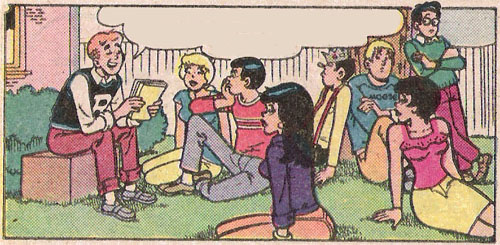
25
Apr
18
Apr
12
Apr
Waiting For Improved Archie
Posted by MGK Published in Archie (Improved Or Otherwise), Comics, Interactive Fun Time Party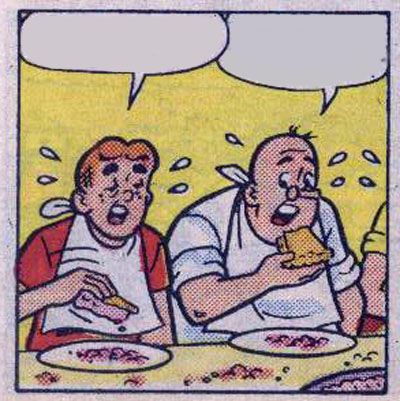
11
Apr
8
Apr
Most of Marvel’s recent1 crossover events, if nothing else, have all had a good, simple byline for curious readers. House of M: “the Scarlet Witch changes reality and then there is a big fight.” Civil War: “Marvel’s heroes pick sides and have a big fight.” Secret Invasion: “Skrulls invade and there is a big fight.” Siege: “Norman Osborn invades Asgard and there is a big fight.” And so on and so forth. There may be twists and turns, but generally after one issue you know the basic reason as to why there is going to be a big fight, and that is the important thing.
Fear Itself boldly goes a different direction: its first issue reads like a #0 issue. There is a bit of Odin beating the hell out of Thor, but barely that. There is a bit of Sin fighting some Nazis, but villains beating up nameless flunky losers is never really that interesting to begin with. There is a riot so vague that you have to wonder if its vagueness is a plot point (seriously, at one point Captain America – er, Steve Rogers – is asked about “the issue” in a way that makes it seem quite possible that they intended to insert one but just forgot and then at some point a typesetter removed the brackets from “[ISSUE]”). It seems to be referring to the Ground Zero mosque debate from last year, sort of, but a Marvel Universe equivalent thereof where nobody ever says anything specific.2
And then the gods of Asgard go… back to Asgard. Presumably this is meant to be dramatic somehow, but I’m not sure why the gods of Asgard going back to Asgard is a big deal at this point. I don’t read Thor – to be perfectly honest it’s the one Marvel property I have never been able to really get into, regardless of who was writing or drawing it – but I know that the gods of Asgard are traditionally in Asgard, and that making this be a Big Deal seems wrong, much as it would be silly to make it be a Big Deal when Spider-Man starts wearing his regular costume again or when Steve Rogers becomes Captain America again. That doesn’t mean writers won’t try, but status-quo-restoring events are almost always less enthralling than disruptive ones: Captain America Reborn wasn’t as good as The Death of Captain America, Knightsend wasn’t as good as Knightfall, and so on.3
Equally silly is having Odin ruminate about a “final prophecy.” Never mind that it’s obviously bull in an ongoing comics universe to have a “final prophecy” be a plot element to begin with – after all, what’s the next writer going to do, except say “well, there’s actually a final-er prophecy.” But I know enough about Thor in the Marvel Universe to know that the reason the gods are on Earth right now (and, presumably, the reason Thor has a new costume) is because Ragnarok already happened in the Marvel Universe. It was the whole reason JMS had to write how Loki was a chick for a while. Come to think, it’s the reason the gods of Asgard are on Earth in the first place. How does a Norse pantheon get more final than frigging Ragnarok? Is this Ragnarok II: Pseudo-Norse Boogaloo?
Other than that, the issue’s big reveal is that there’s another Norse deity with another hammer and another Odin, or at least someone who suggests that the Odin that’s beating up Thor is a replacement Odin, like a Norse equivalent of Dick Whitman pretending to be Don Draper. All of this feels kind of repetitive, because it’s kind of repetitive: at present it feels like the same old “hey, what if there was another version of [HERO]” that’s basically been the same story over and over again in Green Lantern for the past four or five years.4
(Granted, “another version of something” has been a comic storytelling tool since writers first decided there could be more than one type of Kryptonite. But ultimately, the problem with it is that it’s only as useful as the property you’re re-versioning is popular. I was mildly interested in Green Lantern, so different coloured and themed Lanterns was mildly interesting to me; I don’t really give much of a damn about Thor, so I am not Fear Itself’s target market, and my dissatisfaction with the book therefore comes with a huge caveat.)
That having been said, I have a lot of faith in Matt Fraction’s storytelling abilities; the man has written a bunch of my favorite superhero comics of the past five years, including two (Immortal Iron Fist and Invincible Iron Man) that would make my top five. So I’m willing to give him time to rebound from what’s ultimately a lackluster beginning. But a lackluster beginning it unfortunately is.
- Okay, I know that going back to 2005 stretches the definition of “recent,” but you know where I’m going with this. [↩]
- Maybe they’ll get Doctor Doom to cry again. [↩]
- Final Crisis: Legion of Three Worlds is the rare exception of a status-quo-restoring event that’s generally better than what disrupted the status quo, but this is mostly because those disruptive comics were so incredibly shitty that a basically okay comic book was able to seem like spun gold in comparison. [↩]
- It doesn’t help that Skadi doesn’t actually appear to be associated with a hammer in traditional Norse mythology, making her feel somewhat shoehorned into the role of Anti-Thor. [↩]
6
Apr
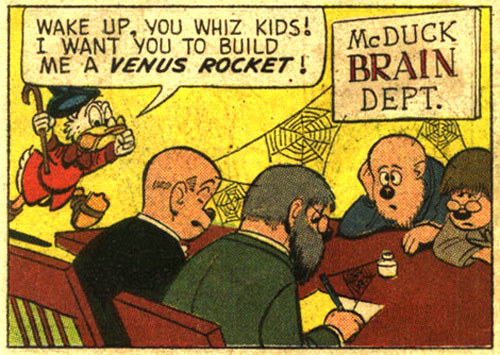
Also, you should see Scrooge’s healthcare plan. It is the bomb, yo.
4
Apr
Search
"[O]ne of the funniest bloggers on the planet... I only wish he updated more."
-- Popcrunch.com
"By MightyGodKing, we mean sexiest blog in western civilization."
-- Jenn
Contact
MGKontributors
The Big Board
MGKlassics

Blogroll
- ‘Aqoul
- 4th Letter
- Andrew Wheeler
- Balloon Juice
- Basic Instructions
- Blog@Newsarama
- Cat and Girl
- Chris Butcher
- Colby File
- Comics Should Be Good!
- Creekside
- Dave’s Long Box
- Dead Things On Sticks
- Digby
- Enjoy Every Sandwich
- Ezra Klein
- Fafblog
- Galloping Beaver
- Garth Turner
- House To Astonish
- Howling Curmudgeons
- James Berardinelli
- John Seavey
- Journalista
- Kash Mansori
- Ken Levine
- Kevin Church
- Kevin Drum
- Kung Fu Monkey
- Lawyers, Guns and Money
- Leonard Pierce
- Letterboxd – Christopher Bird - Letterboxd – Christopher Bird
- Little Dee
- Mark Kleiman
- Marmaduke Explained
- My Blahg
- Nobody Scores!
- Norman Wilner
- Nunc Scio
- Obsidian Wings
- Occasional Superheroine
- Pajiba!
- Paul Wells
- Penny Arcade
- Perry Bible Fellowship
- Plastikgyrl
- POGGE
- Progressive Ruin
- sayitwithpie
- scans_daily
- Scary-Go-Round
- Scott Tribe
- Tangible.ca
- The Big Picture
- The Bloggess
- The Comics Reporter
- The Cunning Realist
- The ISB
- The Non-Adventures of Wonderella
- The Savage Critics
- The Superest
- The X-Axis
- Torontoist.com
- Very Good Taste
- We The Robots
- XKCD
- Yirmumah!
Donate
Archives
- August 2023
- May 2022
- January 2022
- May 2021
- January 2021
- December 2020
- October 2020
- June 2020
- March 2020
- January 2020
- December 2019
- October 2019
- February 2019
- January 2019
- December 2018
- April 2018
- March 2018
- February 2018
- January 2018
- December 2017
- November 2017
- October 2017
- February 2017
- January 2017
- December 2016
- November 2016
- October 2016
- September 2016
- August 2016
- July 2016
- June 2016
- May 2016
- April 2016
- March 2016
- February 2016
- January 2016
- December 2015
- November 2015
- October 2015
- September 2015
- August 2015
- July 2015
- June 2015
- May 2015
- April 2015
- March 2015
- February 2015
- January 2015
- December 2014
- November 2014
- October 2014
- September 2014
- August 2014
- July 2014
- June 2014
- May 2014
- April 2014
- March 2014
- February 2014
- January 2014
- December 2013
- November 2013
- October 2013
- September 2013
- August 2013
- July 2013
- June 2013
- May 2013
- April 2013
- March 2013
- February 2013
- January 2013
- December 2012
- November 2012
- October 2012
- September 2012
- August 2012
- July 2012
- June 2012
- May 2012
- April 2012
- March 2012
- February 2012
- January 2012
- December 2011
- November 2011
- October 2011
- September 2011
- August 2011
- July 2011
- June 2011
- May 2011
- April 2011
- March 2011
- February 2011
- January 2011
- December 2010
- November 2010
- October 2010
- September 2010
- August 2010
- July 2010
- June 2010
- May 2010
- April 2010
- March 2010
- February 2010
- January 2010
- December 2009
- November 2009
- October 2009
- September 2009
- August 2009
- July 2009
- June 2009
- May 2009
- April 2009
- March 2009
- February 2009
- January 2009
- December 2008
- November 2008
- October 2008
- September 2008
- August 2008
- July 2008
- June 2008
- May 2008
- April 2008
- March 2008
- February 2008
- January 2008
- December 2007
- November 2007
- October 2007
- September 2007
- August 2007
- July 2007
- February 2007
Tweet Machine
- No Tweets Available
Recent Posts
- Server maintenance for https
- CALL FOR VOTES: the 2021 rec.sport.pro-wrestling Awards
- CALL FOR NOMINATIONS: The 2021 rec.sport.pro-wrestling Awards (the Theszies)
- The 2020 RSPW Awards – RESULTS
- CALL FOR VOTES: the 2020 Theszies (rec.sport.pro-wrestling Awards)
- CALL FOR NOMINATIONS: The 2020 Theszies (rec.sport.pro-wrestling awards)
- given today’s news
- If you can Schumacher it there you can Schumacher it anywhere
- The 2019 RSPW Awards – RESULTS
- CALL FOR VOTES – The 2019 RSPW Awards (The Theszies)
Recent Comments
- Scott Hater in Bing, Bang, Bing, Fuck Off
- dan loz in Hey, remember how we talked a while a back about b…
- Sean in Server maintenance for https
- Ethan in CALL FOR VOTES: the 2021 rec.sport.pro-wrestling A…
- wyrmsine in ALIGNMENT CHART! Search Engines
- Jeff in CALL FOR VOTES: the 2021 rec.sport.pro-wrestling A…
- Greg in CALL FOR VOTES: the 2021 rec.sport.pro-wrestling A…
- DragoMaster009 in Grading Every Country's National Anthem, Part Four…
- DragoMaster009 in Review: The League of Regrettable Superheroes
- DragoMaster009 in MGK Ranks Every Live-Action Marvel Movie Since 199…

